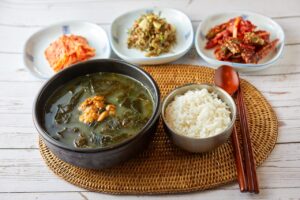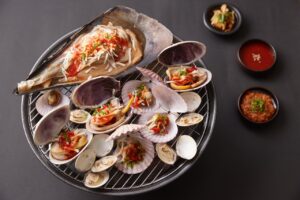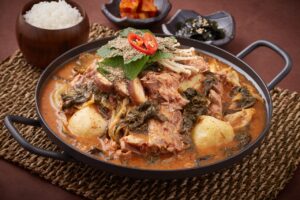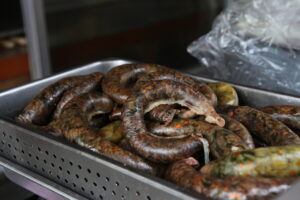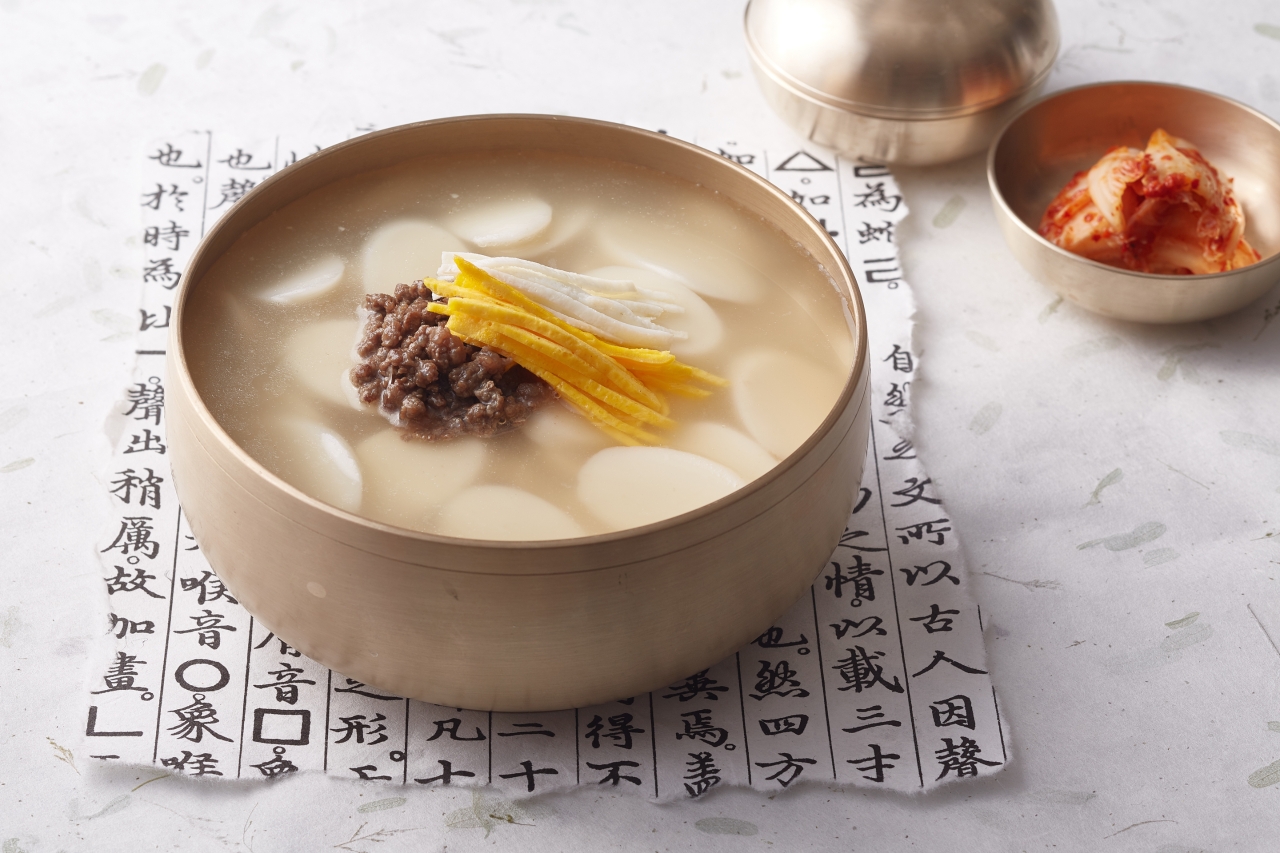
Tteokguk with Kimchi ⓒ한국관광공사 사진갤러리-디그램
Meaning of Tteokguk in Korea?
The phrase “If you eat tteokguk, you will be one year older” is a traditional saying in Korea that is associated with the custom of consuming tteokguk (rice cake soup) on Korean New Year’s Day (Seollal). It reflects the cultural and symbolic significance of tteokguk in Korean traditions.
In Korean culture, age is highly respected and celebrated, and the concept of gaining a year of age is a central part of this tradition. On New Year’s Day, everyone in Korea is considered to become one year older, regardless of their actual birthdate. This practice is known as “Korean age” or “man-nai” (만나이).
Eating it on New Year’s Day is not only a culinary tradition but also a way of symbolizing this age increase. It is believed that by consuming tteokguk, a person is ceremonially marking the passage of another year and is wishing for good luck and a prosperous future. Therefore, the saying “If you eat tteokguk, you will be one year older” reflects the belief that participating in this tradition is a way to start the new year on the right foot, ensuring blessings and longevity.
This custom is deeply ingrained in Korean culture and is a beautiful example of how food, tradition, and symbolism are intertwined in the customs of a particular society.
What is Tteokguk?
Tteokguk, also known as ddeokguk or tteok guk, is a traditional Korean soup made primarily with rice cakes called “tteok” (떡). This dish is a staple in Korean cuisine and has cultural significance, often associated with the celebration of the Korean New Year (Seollal).
Key features of tteokguk include:
- Tteok (Rice Cakes): The primary ingredient in tteokguk is rice cakes, which come in various shapes and sizes. They symbolize good luck and are said to bring good fortune for the coming year. The tradition of eating tteokguk on New Year’s Day signifies gaining a year of age.
- Broth: Tteokguk is prepared with a clear, savory broth, which is typically made by simmering beef, such as brisket or flank, along with various seasonings and aromatics. The broth is essential for flavoring the dish.
- Garnishes: Tteokguk is often garnished with additional ingredients like thin strips of cooked beef, scrambled eggs, seaweed (usually thinly sliced strips of toasted seaweed), and chopped scallions. These garnishes provide additional texture and flavor to the soup.
- Seasonings: The broth is seasoned with ingredients like soy sauce, garlic, and sometimes sesame oil to enhance the overall flavor.
This is considered a comforting and symbolic dish, with its consumption on New Year’s Day being a tradition that is deeply ingrained in Korean culture. The act of eating it is not only a culinary tradition but also a way of celebrating the beginning of a new year and paying respect to one’s ancestors and heritage. It’s a beloved and meaningful part of Korean cuisine.
History
A traditional Korean rice cake soup, has a history deeply rooted in Korean culture and tradition. While the exact origins of tteokguk are difficult to trace, it has been a significant part of Korean cuisine for centuries. Here’s a brief overview of the history of tteokguk:
- Ancient Origins: Rice has been a staple in Korean diets for thousands of years, and rice cakes (tteok) have been made in Korea since ancient times. Tteok was used for various purposes, from offerings in ancestral rites to everyday meals. The practice of making and consuming rice cake soup likely dates back to early Korean history.
- Symbolism: Tteokguk has long been associated with symbolism and rituals. The round shape of the rice cakes symbolizes the sun and the cycle of life, and eating tteokguk on the Korean New Year (Seollal) has been a tradition for centuries. It’s believed that consuming tteokguk on New Year’s Day brings good luck and represents the wish for a prosperous and healthy year ahead.
- Cultural Significance: Tteokguk is not only a culinary tradition but also a cultural one. In Korea, there is a strong emphasis on age and respect for one’s elders. Eating tteokguk on New Year’s Day signifies that a person has aged another year and is a way of showing respect for one’s elders. It’s a practice that fosters family togetherness and the preservation of traditions.
- Variations: Over the years, various regions of Korea have developed their own variations of tteokguk. These variations can differ in terms of ingredients, preparation methods, and flavor profiles. Each region may have its unique twist on this classic dish.
- Year-Round Dish: While tteokguk is closely associated with New Year’s celebrations, it is enjoyed throughout the year in Korea. Some people eat it as a comfort food or special dish for birthdays and other important occasions.
In summary, tteokguk is a dish deeply ingrained in Korean culture and tradition. Its history is tied to the symbolism of rice cakes, the celebration of the New Year, and the values of respect and family. It remains a beloved and meaningful part of Korean cuisine, passed down through generations.

Cooking Method
Tteokguk is a traditional Korean rice cake soup typically enjoyed during the Korean New Year, but it can also be made and enjoyed throughout the year. Here’s a basic recipe for making tteokguk:
Ingredients:
- 1 cup of sliced tteok (rice cakes) – You can use cylindrical or oval-shaped tteok.
- 6 cups of beef or chicken broth
- 1/2 pound of thinly sliced beef (such as brisket or flank steak)
- 2 cloves of garlic, minced
- 2 teaspoons of soy sauce
- Salt to taste
- 2 large eggs
- 2 sheets of toasted seaweed (gim), cut into thin strips
- 2 green onions, chopped
- Sesame oil (optional)
- Black pepper (optional)
Instructions:
- Prepare the Rice Cakes: If the rice cakes are hard, you can soak them in cold water for about 30 minutes to soften them. Drain before using.
- Make the Broth: In a large pot, bring the beef or chicken broth to a boil. Add the minced garlic and soy sauce to the broth. Season with a bit of salt to taste. You can adjust the saltiness later if needed.
- Cook the Beef: Add the thinly sliced beef to the boiling broth. Cook for a few minutes until the beef is no longer pink and has cooked through. You can skim off any impurities that rise to the surface.
- Add the Rice Cakes: Gently add the sliced rice cakes to the boiling broth and cook them for about 5-7 minutes, or until they become soft and chewy.
- Prepare the Garnishes: While the rice cakes are cooking, prepare the garnishes. Beat the eggs in a bowl and make a thin omelet. Then, cut the omelet into thin strips. Also, chop the green onions and cut the toasted seaweed into thin strips.
- Assemble the Soup: When the rice cakes are soft, taste the broth and adjust the seasoning if needed with more salt. If you like, you can add a touch of sesame oil and black pepper for extra flavor. Remove the pot from the heat.
- Serve: Ladle the tteokguk into individual serving bowls. Garnish each bowl with the egg strips, green onions, and toasted seaweed.
- Enjoy: Tteokguk is traditionally served hot and can be enjoyed with kimchi or other side dishes.
This is a basic recipe for making tteokguk. Variations of tteokguk exist, with some recipes incorporating different ingredients like vegetables or seafood. You can also adjust the flavor to suit your personal preferences. Remember that tteokguk is not just a delicious soup but also a meaningful tradition in Korean culture, especially when enjoyed on New Year’s Day.

